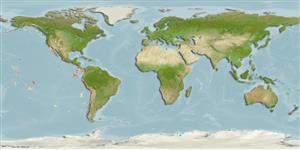Holocéfalos (quimeras) (chimaeras) >
Chimaeriformes (Chimaeras) >
Chimaeridae (Shortnose chimaeras or ratfishes)
Etymology: Hydrolagus: hydro-, combining form of hydor (Gr.), water; lagos (Gr.), hare, i.e., “water rabbit,” probably referring to three pairs of tooth plates, which tend to protrude from the mouth like a rabbit’s incisors. (See ETYFish); macrophthalmus: macro-, from makros (Gr.), long; ophthalmos (Gr.), eye, referring to its large oval eyes. (See ETYFish).
Environment: milieu / climate zone / depth range / distribution range
Ecología
marino batidemersal; rango de profundidad 590 - 1160 m (Ref. 97389). Subtropical
Distribución
Países | Áreas FAO | Ecosistemas | Ocurrencias, apariciones | Point map | Introducciones | Faunafri
Eastern Pacific: from the central coast of Mexico, Costa Rica, Peru and Chile.
Tamaño / Peso / Age
Maturity: Lm ? range ? - ? cm
Max length : 63.9 cm TL macho / no sexado; (Ref. 97389); 58.1 cm TL (female)
Short description
Morfología | Morfometría
This species is distinguished by the following set of characters: slender body; short and bluntly rounded snout; relatively short head (HDL 24.2-24.5% BDL); relatively large eyes (EYL 30.9-34.2% HDL); oral and preopercular lateral line canals sharing a short common branch from the infraorbital canal; relatively large pectoral fins (P1A 36.5-40.8% BDL), extending posterior to the insertion of pelvic fins; trunk's lateral line canal without sinusoidal undulations; the anterior and posterior regions of second dorsal fin considerably taller than middle region; no anal fin; tail region elongate and slender (PCA 58.3-59.9% BDL); caudal-fin axis horizontal with the fin nearly symmetrical, epaxial and hypaxial lobes equal sized; coloration uniform brown across entire body, no white markings and bluish fins (Ref. 97389).
Oviparous (Ref. 205). Eggs are encased in horny shells (Ref. 205).
Life cycle and mating behavior
Madurez | Reproducción | Puesta | Huevos | Fecundidad | Larva
Angulo, A., M.I. López, W.A. Bussing and A. Murase, 2014. Records of chimaeroid fishes (Holocephali: Chimaeriformes) from the Pacific coast of Costa Rica, with the description of a new species of Chimera (Chimaeridae) from the eastern Pacific Ocean. Zootaxa 3861(6):554-574. (Ref. 97389)
IUCN Red List Status (Ref. 130435)
Threat to humans
Harmless
Human uses
Más información
PaísesÁreas FAOEcosistemasOcurrencias, aparicionesIntroduccionesStocksEcologíaDietacomponentes alimenticiosconsumo de alimentoRación
Age/SizeCrecimientoLength-weightLength-lengthLength-frequenciesMorfometríaMorfologíaLarvaDinámica larvariaReclutamientoAbundanciaBRUVS
ReferenciasAcuiculturaPerfil de acuiculturaRazasGenéticaElectrophoresesheritabilidadEnfermedadesProcesamientoNutrientsMass conversion
ColaboradoresImágenesStamps, Coins Misc.SonidosCiguateraVelocidadTipo de nataciónSuperficie branquialOtolitosCerebrosVisión
Herramientas
Special reports
Download XML
Fuentes de Internet
Estimates based on models
Phylogenetic diversity index (Ref.
82804): PD
50 = 0.5000 [Uniqueness, from 0.5 = low to 2.0 = high].
Bayesian length-weight: a=0.00282 (0.00118 - 0.00673), b=3.10 (2.89 - 3.31), in cm total length, based on LWR estimates for this (Sub)family-body shape (Ref.
93245).
Nivel trófico (Ref.
69278): 3.8 ±0.6 se; based on size and trophs of closest relatives
Resiliencia (Ref.
120179): Bajo, población duplicada en un tiempo mínimo de 4.5-14 años (Assuming Fec <100).
Fishing Vulnerability (Ref.
59153): Moderate to high vulnerability (46 of 100).
Nutrients (Ref.
124155): Calcium = 38.6 [9.8, 112.6] mg/100g; Iron = 0.933 [0.321, 3.831] mg/100g; Protein = 16.9 [11.3, 20.1] %; Omega3 = 0.325 [0.136, 0.762] g/100g; Selenium = 40.6 [8.9, 111.7] μg/100g; VitaminA = 8.59 [2.78, 25.30] μg/100g; Zinc = 0.599 [0.309, 1.157] mg/100g (wet weight);
